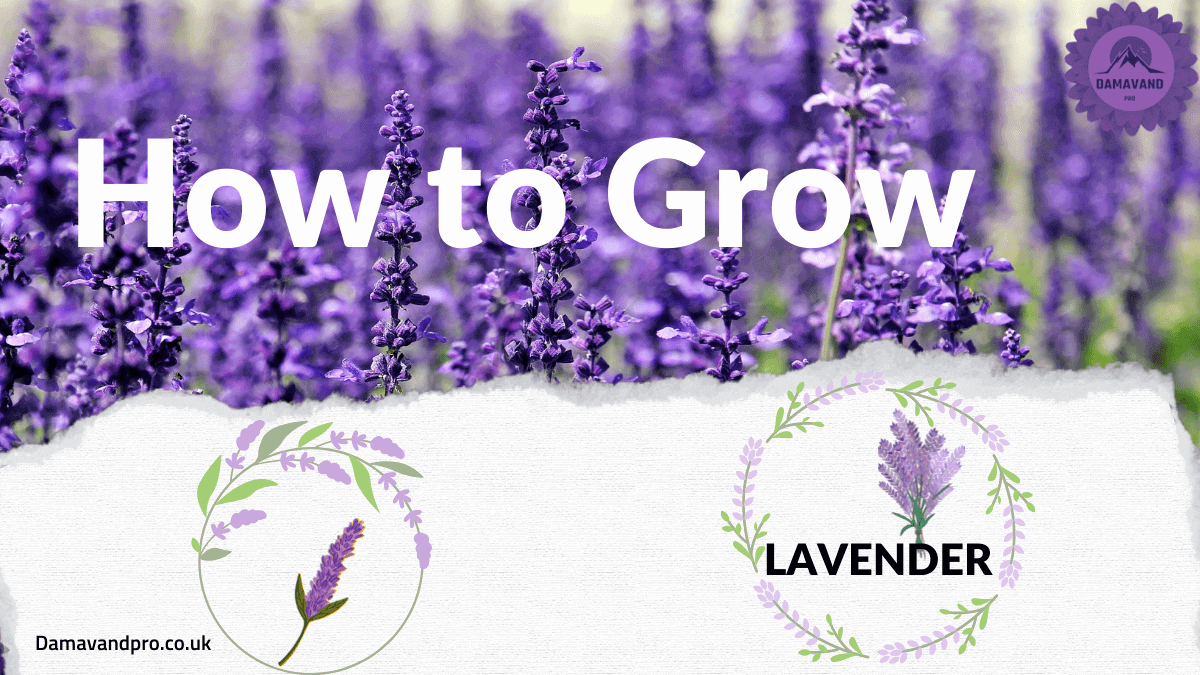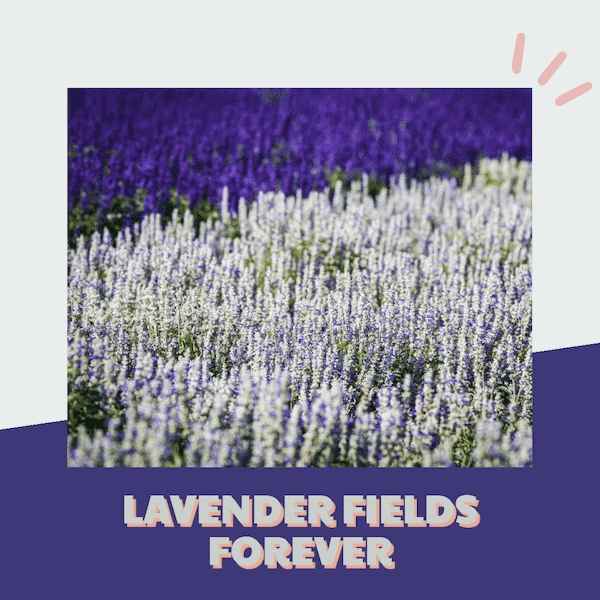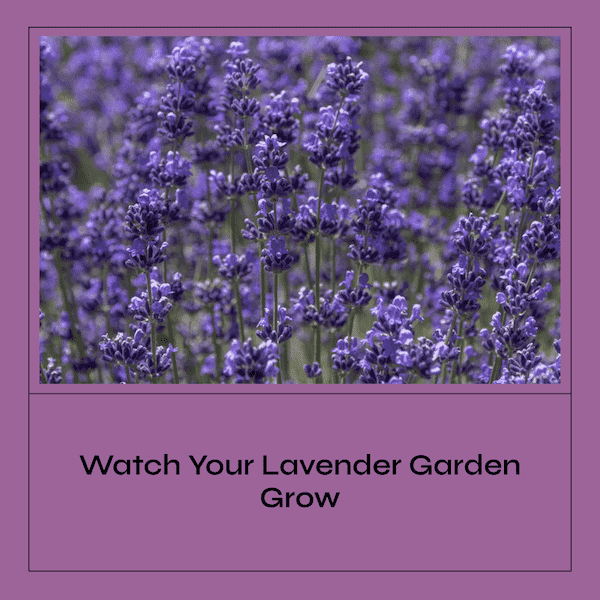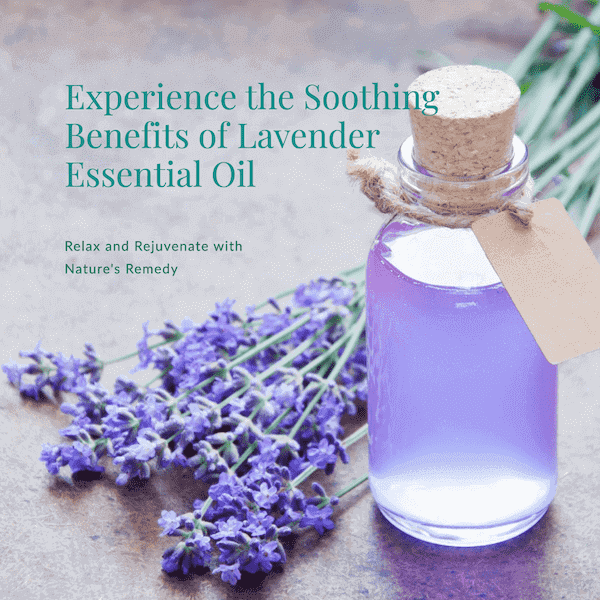+447709283333 | info@damavandpro.com

How to grow lavender from seeds
How to grow lavender
Lavender is an excellent perennial flower that attracts butterflies, bees, & other pollinators to your garden. This Mediterranean native is now cultivated, grown, & adored worldwide. Plant them alongside your herb garden, in a perennial flower bed, or in containers to enjoy their fragrance up close. You’ll be amazed at how beautiful & useful lavender plants are in your garden if you follow our growing lavender plant guide!
Plant lavender seeds
To plant lavender seeds, follow these steps:
- Choose a suitable location. Lavender prefers well-draining soil & full sunlight. Choose a location in your garden or outdoor space that gets at least 6 hours of direct sunlight per day & has well-draining soil.
- Prepare the soil: Lavender prefers a slightly alkaline soil with a pH of around 7.5–8.5. If necessary, adjust the pH of your soil by adding lime or wood ash. You can also enrich the soil with compost or organic matter to help improve drainage & fertility.
- Sow the seeds: Lavender seeds are very small, so it’s best to mix them with fine sand or soil before sowing. Scatter the seeds over the prepared soil, being careful not to plant them too deeply. You can use your hand to gently sprinkle the seeds over the soil, or use a seed spreader if you have a larger area to cover.
- Cover the seeds: Once the seeds are sown, cover them lightly with a thin layer of soil or compost. Alternatively, you can sow the seeds on top of the soil & then cover them with a layer of mulch to help keep the soil moist & prevent erosion.
- Water the seeds: Water the seeds gently to help them germinate. Be sure to keep the soil moist, but not waterlogged, until the seeds have sprouted & established themselves.
By following these steps, you can successfully plant lavender seeds & enjoy a beautiful display of flowers in your garden or outdoor space. Remember to be patient, as it can take a few weeks for the seeds to germinate & start growing.
Tips for Successfully Growing Lavender in the UK
Lavender is a beautiful & fragrant plant that is well-suited to growing in the UK. Here are some tips for successfully growing lavender in the UK:
- Choose a sunny spot: Lavender needs plenty of sunlight to thrive, so choose a spot in your garden that gets at least 6 hours of direct sunlight per day.
- Prepare the soil: Lavender prefers well-draining soil that is slightly alkaline. If your soil is heavy or clay-like, mix in some sand or well-rotted compost to improve drainage.
- Plant your lavender. Lavender can be grown from seeds or purchased as young plants from a garden center. Plant your lavender at the same depth as it was in the pot, & space the plants about 45cm (18 inches) apart.
- Water regularly: Lavender is drought-tolerant, but it still needs regular watering to establish itself & grow well. Water your lavender once a week, or more frequently in hot, dry weather.
- Prune regularly: Prune your lavender regularly to encourage new growth & keep the plant looking neat & tidy. Prune off any dead or damaged stems & cut back the plants by about a third after they have finished flowering.
- Keep it safe from frost: Although lavender is typically hardy in the UK, frost can still harm it. If you live in an area with cold winters, consider planting your lavender in a sheltered spot or covering it with a frost cloth during cold spells.
Soil lavender
Lavender plants prefer well-draining soil with a pH that is slightly alkaline, between 6.5 & 7.5. They also prefer soil that is not too wet or too dry, & they need good air circulation around the roots to prevent problems with pests & diseases.
If you are planting lavender in a new garden bed, you may need to prepare the soil to ensure that it meets these requirements. To do this, you can mix in some compost or other organic matter to improve the soil structure & drainage. You can also add lime to raise the pH of the soil if necessary.
It’s also a good idea to avoid over-watering lavender plants, as they are prone to root rot if the soil is too wet. Water the plants deeply, but allow the soil to dry out slightly between waterings.
If you are planting lavender in pots, choose a container with good drainage & use a well-draining potting mix specifically designed for herbs. Be sure to use a container that is large enough to accommodate the roots of the lavender plants & to allow for proper drainage.
When & Where to Plant lavender flowers
- Light: Lavender flowers grow best in full sun & well-drained soil. Afternoon shade may help them thrive in hot summer climates.
- Soil: Lavender flowers grow best in low- to moderately fertile soils, so don’t add organic matter to the soil before planting. Lavender flowers thrive in soils that are neutral to slightly alkaline. For best results, add lime to raise the soil pH to around 7.0. We recommend performing a simple soil test.

The Best Time to Deadhead Lavender in the UK & Keep Your Garden Looking Its Best
It’s generally best to deadhead lavender plants in the UK in the summer, after the plants have finished flowering. This can help encourage new growth & keep the plants looking neat & tidy.
To deadhead lavender, simply snip off the spent flowers using a pair of scissors or pruning shears. Make sure to cut just above the first set of leaves below the flower head. Avoid cutting into the woody part of the plant, as this can damage the plant.
It’s also a good idea to remove any dead or damaged stems or branches while deadheading. This can help promote healthy new growth & keep the plant looking its best.
It’s important to note that lavender plants typically flower only once per year, so deadheading them too aggressively can reduce the number of flowers that the plant produces. Be sure to leave some flowers on the plant to allow for seed production and encourage pollinators.
Lavender flowers
Lavender is an aromatic perennial plant that is prized for its fragrant flowers & foliage. The flowers of lavender plants are typically purple, but they can also be white or pink. Lavender flowers are small & tubular in shape, & they are borne in clusters on tall spikes.

Lavender flowers are highly fragrant & are often used in perfumes, sachets, & other fragrant products. In addition to their fragrance, lavender flowers are also known for their medicinal properties, & they have been used for centuries to treat a variety of ailments, including anxiety, insomnia, & skin irritation.
Lavender plants are native to the Mediterranean region, but they are now grown widely around the world. They are drought-tolerant & can thrive in a variety of soil types, making them well-suited for use in dry, sunny locations. Lavender plants can be grown in pots or in the ground, & they are often used as border plants or in herb gardens.
Lavender Planting Instructions: A Step-by-Step Guide
- Begin with plants that are robust & have established root systems.
- Create a planting hole twice as broad & deep as the root ball of your lavender plant. When planting many plants, you can either prepare the soil in each planting hole individually or the entire bed at once. Create a well-draining soil mixture in a container by mixing dirt with gravel or sand.
- You can “rough up” the roots if they are clinging to the pot’s sides in order to promote outward development.
- Set your lavender in the ground so that the top of the root ball is level with the soil. Place more soil around the plant & firmly pack it down.
- Water is used to remove air pockets & compact the soil. Only water your lavender in the upcoming weeks if the plant & the garden as a whole are extremely dry. Keep in mind that lavender prefers soil with rapid drainage rather than “wet feet” or standing water, which can cause the roots to rot.
Lavender Plant Growing Instructions
growing lavender from seed

Habit of Growth: In warmer areas, lavender develops into a rounded, bushy shrub. In colder areas, it is a perennial that grows more slowly. To avoid fungus or powdery mildew in humid conditions, make sure there is enough room for appropriate airflow. To assess the mature size of the types you are growing, have a look at them.
- Staking is not necessary for lavender plants, which can grow to be between one & three feet tall & wide.
- Watering: Give young plants lots of water. Lavender is drought-resistant once it has grown & doesn’t require much watering. Lavender plants frequently experience stress from overwatering.
- Fertilizing: Just like with watering, less is more when it comes to fertilizer for lavender. Your lavender plants shouldn’t require any fertilizer.
- Mulching: Except in extreme cases, lavender should not require mulch to conserve soil moisture because it is drought-tolerant. If you mulch, use small-sized bark or gravel & leave several inches of space around the plant crown, or your lavender will rot. Light-colored gravel or sand mulch can aid in drainage while also keeping the soil & plants warm.
- Pruning & trimming: Lavender blooms in the summer & requires trimming & pruning. Fresh or dried flower stalks can be harvested & used. Even if you aren’t going to use the lavender flowers, cut off the deadheads after the flowers fade to spruce up the plant & encourage a second flowering. Lavender is a tree-like plant. Young stems produce the best & most fragrant foliage & flowers. In the spring, prune 2-year-old & older plants by cutting the woody stems back by one-third. This will stimulate new growth, resulting in improved foliage & flowering.
Lavender Care at the End of the Season
Mulching lavender plants in late fall can defend them from the winter cold in its northern range. When a freeze occurs, pile wood chips or bark mulch on the plants. This can keep them warm but not cause them to rot. In the early spring, take away the mulch.
Pests & Diseases: Pests & Diseases: several pests, like cervid & beetles, avoid lavender as a result of it’s terribly redolent nature. Mildew & alternative plant diseases, on the other hand, are often a drag in wet areas. Plants ought to be spaced apart & in a region with smart air circulation to forestall the unfolding of flora diseases. This can keep the leaves dry & make them less vulnerable to plant life.
In its northern range, lavender plants can be protected from the winter cold by mulching them in late fall. Cover the plants with wood chips or bark mulch when it freezes. This can keep them warm but not cause them to rot. Remove the mulch as soon as spring arrives.
Layering is another method of propagation. Bend a healthy, 8-inch-long lower lavender branch to the ground in spring, remove the leaves where they touch the ground, & scar the branch with a knife in that spot.
Cover the wound with soil & leave the rest of the branch sticking out of the ground after dusting it with rooting hormone powder. It should take root within a year. Cut it away from the mother plant once it has rooted, & transplant it to a new location.
Lavender can also self-sow if the flower stalks are left on the plant. Decide whether you want a lot of baby lavenders in that area of the garden; if not, deadhead frequently.
lavender deadheading
Deadheading lavender is the process of removing spent flowers from the plant to encourage new growth & promote a longer blooming season. To deadhead lavender, simply use your fingers or a pair of scissors to gently remove the faded flowers from the stem, taking care not to damage the new growth at the base of the plant.
Lavender benefits from deadheading because it helps the plant redirect its energy from producing seeds to producing new flowers. Deadheading also helps keep the plant looking tidy & prevents the spread of self-sowing seeds that can take over the garden.

It’s important to deadhead lavender regularly throughout the growing season, as this will help keep the plant looking its best & encourage new blooms to form. Just be sure to avoid removing too much foliage, as this can weaken the plant & reduce its ability to produce flowers.
When to buy deadhead lavender in the UK
Deadheading lavender is the process of removing spent flowers from the plant. This can be done to improve the appearance of the plant as well as to encourage new growth & prevent the plant from going to seed.
To deadhead lavender, start by identifying the flowers that are no longer in bloom. These flowers will typically be brown or withered. Using clean, sharp scissors or pruning shears, cut off the flowers at the base of the stem, being careful not to damage the leaves or new growth. You can also use your fingers to gently pinch off the flowers, if you prefer.
It’s important to note that lavender flowers are not all produced at the same time, so you may need to deadhead the plant several times throughout the growing season. You can also deadhead lavender as part of regular pruning, which should be done in the late winter or early spring to encourage new growth.
When deadheading lavender, be sure to remove only the flowers & not the entire stem. If you remove too much of the stem, you may damage the plant & reduce its ability to produce new flowers. Additionally, be sure to clean your scissors or pruning shears with rubbing alcohol or a disinfectant to prevent the spread of disease between plants.
When is the best time to deadhead lavender in the UK?
The month of August is ideal for deadheading lavender plants. Proper lavender plant pruning & deadheading will increase your harvest of flower spikes for dried flowers while also making your plants more beautiful & healthy. Lavender benefits greatly from mid-spring pruning & summer deadheading.
Should you deadhead lavender plants?
Deadheading lavender can be a beneficial practice for several reasons.
First, deadheading can improve the appearance of the plant by removing spent flowers, which can make the plant look neater & more attractive. Deadheading also helps to encourage new growth & prevent the plant from going to seed, which can result in more flowers being produced.
In addition, deadheading can help prevent the spread of disease. Lavender flowers that have gone to seed can harbor diseases that can spread to other parts of the plant or to other plants in the garden. By removing these flowers, you can help to prevent the spread of these diseases.
Overall, whether or not you should deadhead your lavender plants will depend on your personal preferences & the needs of your garden. If you want to maintain the appearance of your lavender plants & encourage new growth, then deadheading may be a good option. However, if you are not concerned with the appearance of your plants & do not mind the plant going to seed, then you may choose not to deadhead your lavender.
Grow lavender from seeds
To grow lavender from seeds, you will need the following supplies:
- Lavender seeds
- Seed tray or pots
- Seed compost or potting mix
- Water
Here are the steps to follow:
- Fill the seed tray or pots with seed compost or potting mix & water it lightly.
- Scatter the lavender seeds over the surface of the soil & press them gently into the soil.
- Cover the seeds with a thin layer of soil or seed compost.
- Water the seeds gently, being careful not to wash them away.
- Place the seed tray or pots in a sunny location or under grow lights.
- Keep the soil moist but not waterlogged until the seeds germinate. This can take anywhere from a few days to a couple of weeks, depending on the temperature & humidity.
- Once the seedlings are big enough to handle, transplant them into pots or the garden. Choose a sunny location with well-draining soil.
It’s important to note that lavender seeds can be difficult to germinate, so it may take some patience & persistence. Some gardeners recommend soaking the seeds in water for 24 hours before planting to help improve germination rates. It’s also a good idea to start the seeds indoors in the late winter or early spring, as lavender is a Mediterranean plant that prefers warm weather.
Relaxing effects of lavender
In 888 patients with anxiety disorders, lavender’s anxiolytic effect outperformed the placebo.

Furthermore, lavender alleviated associated symptoms such as restlessness, disturbed sleep, & somatic complaints, as well as having a positive impact on general well-being & quality of life.
Benefits of lavender essential oil

Lavender oil is thought to have antiseptic & anti-inflammatory properties that can aid in the healing of minor burns & bug bites. According to research, it may be beneficial in the treatment of anxiety, insomnia, depression, & restlessness.
lavender benefits
One of the most useful uses for lavender is as a medicinal drug. A study published in the British Journal of Health Psychology discovered that giving lavender oil to people considerably improved their moods, so much so that the study’s authors concluded that “lavender oil & lavender oil are safe & effective in alleviating symptoms related to depression.”
